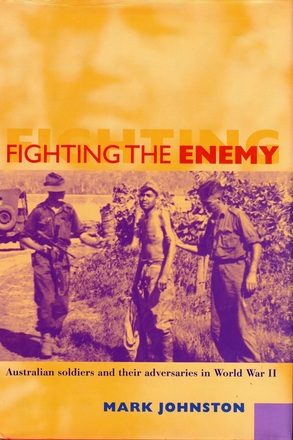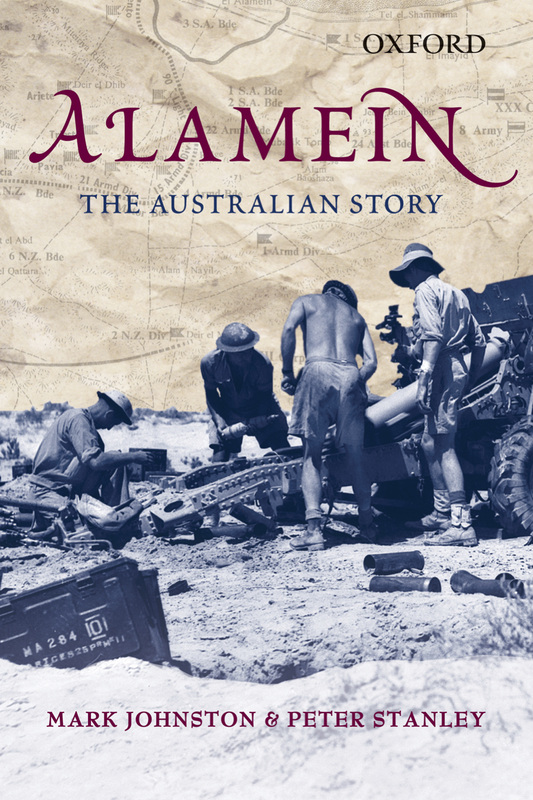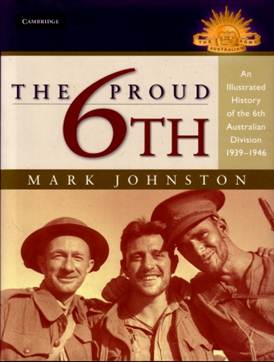|
5. The Silent 7th: An Illustrated History of the 7th Australian Division 1940-4
(Allen and Unwin, Sydney, 2005) Allen and Unwin enabled me to write this companion volume to the 9th Division history. It concerns an outstanding formation, famous for its role in the Kokoda and beachhead campaigns, and fully involved in other battles that are full of interest and drama. The book is at least as well researched and presented as its earlier companion, and again involved the help of numerous veterans and their previously unpublished photos. Three of them - Roger Cundell (18th Brigade), Jim McAllester (21st Brigade) and Mervyn Roberts (25th Brigade) - were tremendously helpful in lending me material and also reading the full manuscript. Unfortunately Allen and Unwin, after producing this beautiful book, did what I considered bafflingly little to promote it. Reviews of The Silent 7th ‘…this book superbly and sympathetically captures the spirit of the division’s men and the era in which they fought. This is as good a general handbook on the campaigns of the 7th Division as you will get.’ Neil James, Defender: The National Journal of the Australia Defence Association, Vol. XXII, No. 2, Winter 2005 |
|
6. The Australian Army in World War II
(Osprey Publishing, Oxford, 2007) Like legions of other military history enthusiasts, I love Osprey books. When I heard that Osprey were interested in publishing Australian titles, I soon found myself exchanging letters about it with one of my favourite historians, Martin Windrow. We soon settled that I would write a book for the Osprey Elite series on the Second AIF. The title suggests that it's on the whole Australian Army, and I do discuss the PMF and CMF. However, I make it clear that the AIF 'was the army's elite' and 'is therefore the focal point of this book.' Again veterans' advice and photos were valuable here. Martin Windrow was a superb editor, and a very impressive person. Of course the focal point of any Osprey tends to be the beautiful colour illustrations and I was very lucky that they were allotted in this book to Carlos Chagas, an exceptionally gifted Brazilian artist. He did a wonderful job, and the inspiration and intense work he put into the project are very apparent. Writing this book was a great experience and I think it's a good starting point for people wanting to read an introduction to the topic. Reviews of The Australian Army in World War II ‘Few historians would be better suited to writing about the Australian soldiers’ battles, weapons and equipment during the Second World War than Mark Johnston. Over the past decade Johnston has become the leading historian on the experience of Australian soldiers during the war. Although slimmer, this book meets the high standards set by his previous works.’ ‘Thoroughly researched and written in a clear and engaging style, this book is sure to appeal to general and specialist readers alike.’ Karl James, Wartime, Issue 41, 2008. |
|
7. The Proud 6th: An Illustrated History of the 6th Australian Division 1939-1946
(Cambridge University Press, Port Melbourne, 2008) This book was a logical successor to my histories of the 9th and 7th Divisions, and became viable when it got the support of both Roger Lee at the Australian Army History Unit and David Horner, editor of the Australian Army History Series. It followed the same format as the other two, with over 200 photos, including some great original ones. A favourite is 9.9, a private photo showing men after a New Guinea patrol. The format is largish, with very good production standards. The numbers of veterans available to help was dwindling rapidly, but I got some remarkable assistance from vets such as Alwyn Shilton, Keith Johnston, Ivor White, and Douglas Margetts. This book had a great launch at the Shrine of Remembrance. Reviews of The Proud 6th ‘Johnston is a master of the archival evidence and sets out the combat history of the division in North Africa, Syria, Greece, Crete and Papua New Guinea as well as writing about the division as a community, with its own codes and conflicts. What makes this an important, perhaps indispensable, book for anyone interested in the army in World War II is the way Johnston uses the 200-odd illustrations… Stephen Matchett, Weekend Australian, November 8-9, 2008. |
|
8. Whispering Death: Australian Airmen in the Pacific War (Allen and Unwin, Sydney, 2011)
My chance to write this book, which in some ways is my best and most important, came about by accident. Peter Stanley was visiting me in Melbourne in mid-2008 and happened to notice that I was reading Fire in the Sky, a massive book about the air war in the Pacific by Eric Bergerud. It emerged that Allen and Unwin had discussed with Peter the idea of him writing a book about the RAAF in the Pacific. Within days Peter said that he felt that he was already juggling several big writing tasks, and suggested that I might take it on. Allen and Unwin's Ian Bowring was gratifyingly willing to allow me to step into the breach thus created. From June 2008 until I submitted the manuscript on 6 July 2010 it dominated every moment that was not spent at Scotch or marking or taking school sport and other activities. I took long service leave for one term in 2010 and devoted it entirely to editing the lengthy manuscript. The result is a book of about 180,000 words. I wrote this at the height of my writing power (I hope I'm still there!) and gave an immense amount of myself to it. Although I've always loved aircraft, I am not a technical expert on them, and I was very lucky to receive help in that area from Peter Hunter, a Qantas pilot and son of a fighter pilot. Veteran pilots and the excellent work of official historians such as Alan Stephens and George Odgers proved invaluable in creating a book ranging in location from India to the Solomons and in time from the 1930s to 1945. I believe this is a good book. It's probably the one to which I devoted most time. Reviews of Whispering Death |
‘…let me say at the outset this is an excellent read because it sets out the sacrifice and bravery of the RAAF in clear and unassailable terms.’ Warren Baker, Reveille, Vol 85, No. 2, March-April 2012
'Whispering Death highlights the courage, skill and self-sacrifice of RAAF members – sadly they were poorly equipped – and is a tribute to over 2000 airmen, who lost their lives in the battle against tyranny. This is a very detailed history and compelling reading.’ JR Bartram AM, Group Captain RAAF (Retd), Mufti, December 2011
‘Military historian Mark Johnston has compiled an excellent short history of RAAF combat operations in the Pacific War.’ ‘I found Whispering Death refreshingly honest in its approach to Australian air operations against the Japanese, giving a frank account of the RAAF’s failures as well as its many outstanding victories.’ J.H. Farrell, Australian and NZ Defender, No. 75, Spring 2011
‘This commendable work…’ ‘This work is hard to put down, the tale makes for compelling reading.’ Flightpath magazine, Vol 23, No. 2, November 2011
|
9. Anzacs in the Middle East: Australian Soldiers, their allies and the local people in World War II (Cambridge University Press, Melbourne, 2013) I made my first notes for this book when gathering material for my PhD thesis, in 1988. In 2002 I began writing a book about the subject, based largely on material gathered in London at the Imperial War Memorial and the National Archives. I also wrote to British publications and appealed for veterans to tell me stories of their interactions with Australian soldiers. I received many useful replies, ranging from the damning to the laudatory. Most were in the latter category. Other projects caused me to put this book aside, and it was not until after finishing Whispering Death that I returned to it. The topic of how Australian soldiers interacted with their allies and the local people in World War II is a big one, and I soon decided to concentrate on the Middle East rather than the whole of the war, though I have the material for the Pacific War. This book was very well produced and has a lot of amusing and powerful stories in it. Reviews of Anzacs in the Middle East: |
'Johnston reveals that he has been thinking about this book for more than 20 years and it shows. There is such a breadth of reading, such a wide range of evidence and one word springs to mind as the reader engages with the book: judicious.'
Michael McKernan, 'In defence of Aussies at War', Canberra Times, 25 May, 2013
|
10. Stretcher-bearers: Saving Australians from Gallipoli to Kokoda (Cambridge University Press, Melbourne, 2015)
Just as the 9th Australian Division and Alamein were topics that struck me early on as fascinating ones, so did stretcher-bearers. Infantrymen repeatedly singled them out for praise in the Second World War. I was attracted by the way bearers routinely risked their lives to save their fellows. Peter Stanley was interested in this topic too, but I could never persuade him to join me in writing a book about them. However, for years he sent me good material on them as he come across it in his World War I research. I had been seriously thinking of this book since 2002 or earlier, and in 2012 I decided to do it. After much thinking over those years I decided on a format with full page pictures opposite text explaining the photos and driving forward the story of the war: or rather the stories of both world wars. In this book, for the first time I researched and wrote about the First World War. I really loved this topic, and I hope my passion for it comes through. Although there was much negotiation with Cambridge over its format and although not all my visions for it came to fruition, I don't think many readers could read it and remain unmoved by its visual power and the words of many of the protagonists. Some were born great, others had greatness thrust upon them, and there were some who couldn't handle it, to coin a phrase. However I am really pleased to have dipped my lid to this unusual and exceptional group of soldiers. Reviews of Stretcher-Bearers: 'This is an impressive publication dedicated to a very impressive part of our Armed forces…The author is no stranger to presenting outstanding portrayals of the various aspects of the service person’s life during armed conflict. With this title he demonstrates, yet again, dedication to detail and scouring of repositories where some of the very fine images, narratives, diaries and firsthand written accounts of these medics have been sourced…This volume is an exceptional published memorial to an exceptional type of service person.' Carl Johnson, Mufti, March 2016 |
11. An Australian Band of Brothers: Don Company, Second 43rd Battalion, 9th Division (NewSouth Publishing, Sydney, 2018)
|
Reviews of An Australian Band of Brothers:
'Johnston's access to the detailed personal accounts [of Gordon Combe, Allan Jones and John Lovegrove] offers the reader an unprecedented insight into the daily lives of these soldiers.' Peter Masters, Australian Defence Magazine, September 2018
'An Australian Band of Brothers is an excellent insight into a Second AIF Battalion's war.' J.H. Farrell, Australian & NZ Defender, No. 102
'Johnston's access to the detailed personal accounts [of Gordon Combe, Allan Jones and John Lovegrove] offers the reader an unprecedented insight into the daily lives of these soldiers.' Peter Masters, Australian Defence Magazine, September 2018
'An Australian Band of Brothers is an excellent insight into a Second AIF Battalion's war.' J.H. Farrell, Australian & NZ Defender, No. 102












